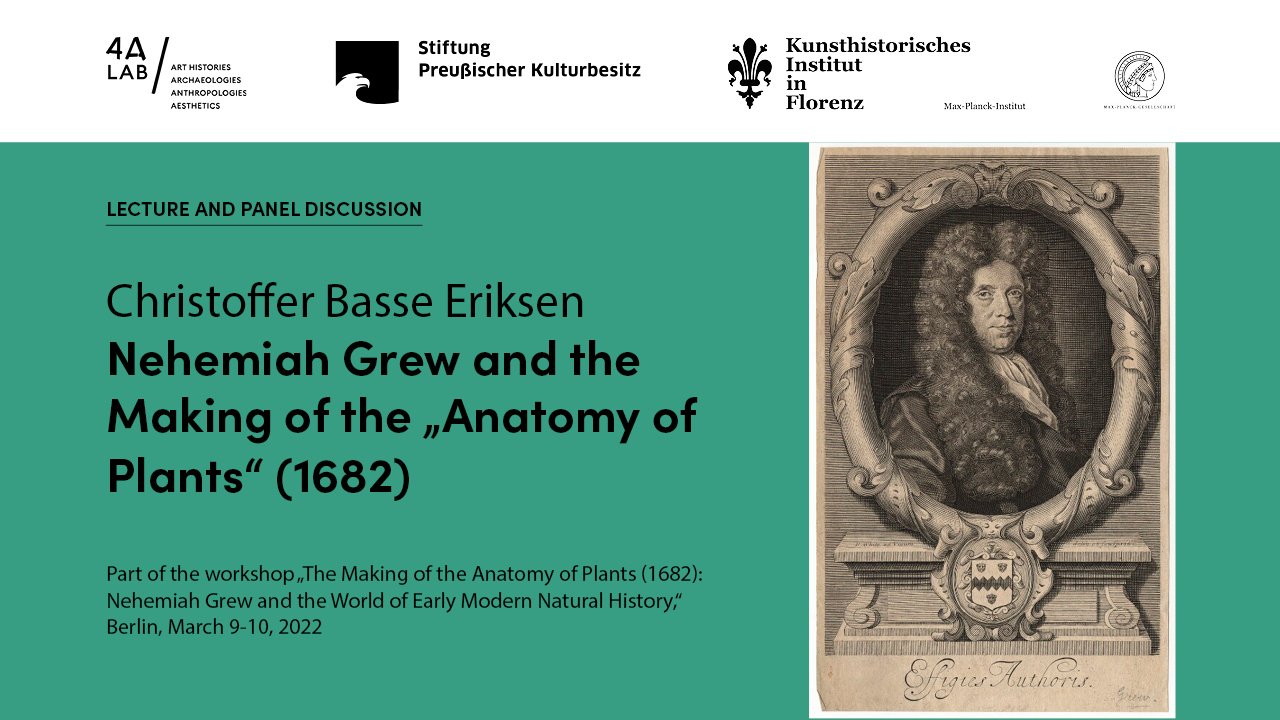Historiography, Humans, Media Library, Plants, Technologies
VIDEO: Nehemiah Grew and the Making of the Anatomy of Plants (1682), by Christoffer Basse Eriksen
How can the “invisible life” of the vegetable world be made visible by means of visual techniques? Christoffer Basse Eriksen’s lecture puts a spotlight on the innovative representational styles devised by 17th-century botanist Nehemiah Grew in his book The Anatomy of Plants (1682), aimed at the dynamic representation of the vegetal processes of generation, germination, and growth. The talk is followed by a response by Prof. Anna Marie Roos (University of Lincoln) and a panel discussion.
06.05.2022

Video #1: Nehemiah Grew and the Making of the “Anatomy of Plants” (1682), by Christoffer Basse Eriksen (Ph.D., Visiting Scholar, Department of History, Humboldt-Universität zu Berlin)
Who was Nehemiah Grew? Born in 1641 to a Presbyterian preacher, educated in Medicine first at Cambridge and then at Leiden, the arch of Grew’s career takes us through many of the arenas in which seventeenth-century intellectual life played out: from the physician’s room, where Grew saw to his patients as a medical doctor, to the Royal Society’s meetings at Gresham College, where he delivered his lectures on plant anatomy, to the “back offices” of the Society’s repository, where he compiled its first museum catalogue, and back to his study, where he drew out plans for the improvement of England’s economy, corresponded with plant-collectors, and wrote a treatise on the reasonableness of Christianity. In this lecture, Christoffer Basse Eriksen contextualizes the life and work of Nehemiah Grew in the panorama of early modern science, highlighting his contribution to the development of the field. Particular attention is devoted to the studies and visual techniques underpinning the botanical representations in Grew’s seminal publication, Anatomy of Plants (1682), and their relation to other disciplines such as anatomy and physiology. In doing so, Christoffer Basse Eriksen shows how Grew’s innovative approach to the vegetable world came to constitute a new science, called “plant anatomy,” aimed at effusing the printed page with the dynamism and liveliness of vegetable life.

Video #2: Response by Anna Marie Roos (University of Lincoln) and Panel Discussion
Anna Marie Roos is a historian of early modern English science and Professor of the History of Science and Medicine at the University of Lincoln. She is internationally recognised for her scholarship in the history of the Royal Society, the development of scientific illustration, and the evolution of the early science museum. Her contribution is followed by a panel discussion moderated by 4a_Lab Fellow Pamela Mackenzie (Kunsthistorisches Institut in Florenz – MPI). The panel is composed by a group of international scholars specialized in the development of early modern science: Fabrizio Baldassarri (Ca’ Foscari Venice/Indiana University Bloomington), Justin Begley (Ludwig-Maximilians-Universität München), Oana Matei (Vasile Goldis Western University of Arad/University of Bucharest), Justin Niermeier-Dohoney (MPI für Wissenschaftsgeschichte, Berlin), and Anna Marie Roos (University of Lincoln).
The event was part of the workshop “The Making of the Anatomy of Plants (1682): Nehemiah Grew and the World of Early Modern Natural History,” organized by Pamela Mackenzie and Christoffer Basse Eriksen in collaboration with Hannah Baader (Head, 4A_Lab). The workshop, which took place in Berlin on March 9-10, 2022 was organized in the framework of a larger project on Nehemiah Grew’s work, in collaboration with the Research and Fellowship Program 4A_Lab: Art Histories, Archaeologies, Anthropologies, Aesthetics.
